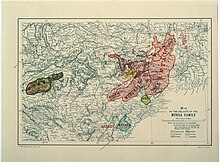
Back لغات موندية Arabic Llingües munda AST Munda dilləri Azerbaijani Мунда (мовы) BE-X-OLD মুন্ডা ভাষা Bengali/Bangla Yezhoù moundek Breton Munda (llengües) Catalan Mundasprog Danish Munda-Sprachen German Zıwanê Munda DIQ
| Munda | |
|---|---|
| Mundaic | |
| Geographic distribution | Indian subcontinent |
| Ethnicity | Munda peoples |
| Linguistic classification | Austroasiatic
|
| Proto-language | Proto-Munda |
| Subdivisions | |
| Language codes | |
| ISO 639-2 / 5 | mun |
| Glottolog | mund1335 |
 Map of areas with significant concentration of Munda speakers | |
The Munda languages are a group of closely related languages spoken by about nine million people in India, Bangladesh and Nepal.[1][2][3] Historically, they have been called the Kolarian languages.[4] They constitute a branch of the Austroasiatic language family, which means they are more distantly related to languages such as the Mon and Khmer languages, to Vietnamese, as well as to minority languages in Thailand and Laos and the minority Mangic languages of South China.[5] Bhumij, Ho, Mundari, and Santali are notable Munda languages.[6][7][1]

The family is generally divided into two branches: North Munda, spoken in the Chota Nagpur Plateau of Jharkhand, Chhattisgarh, Bihar, Odisha and West Bengal, as well as in parts of Bangladesh and Nepal, and South Munda, spoken in central Odisha and along the border between Andhra Pradesh and Odisha.[8][9][1]
North Munda, of which Santali is the most widely spoken and recognised as an official language in India, has twice as many speakers as South Munda. After Santali, the Mundari and Ho languages rank next in number of speakers, followed by Korku and Sora. The remaining Munda languages are spoken by small, isolated groups, and are poorly described.[1]
Characteristics of the Munda languages include three grammatical numbers (singular, dual and plural), two genders (animate and inanimate), a distinction between inclusive and exclusive first person plural pronouns, the use of suffixes or auxiliaries to indicate tense,[10] and partial, total, and complex reduplication, as well as switch-reference.[11][10] The Munda languages are also polysynthetic and agglutinating.[12][13] In Munda sound systems, consonant sequences are infrequent except in the middle of a word.
- ^ a b c d Anderson, Gregory D. S. (29 March 2017), "Munda Languages", Oxford Research Encyclopedia of Linguistics, Oxford University Press, doi:10.1093/acrefore/9780199384655.013.37, ISBN 978-0-19-938465-5
- ^ Hock, Hans Henrich; Bashir, Elena, eds. (23 January 2016). The Languages and Linguistics of South Asia. doi:10.1515/9783110423303. ISBN 9783110423303.
- ^ "Santhali". Ethnologue. Retrieved 21 January 2024.
- ^ Anderson, Gregory D. S. (8 April 2015). The Munda Languages. Routledge. p. 5. ISBN 978-1-317-82886-0.
- ^ Bradley (2012) notes, MK in the wider sense including the Munda languages of eastern South Asia is also known as Austroasiatic
- ^ Pinnow, Heinz-Jurgen. "A comparative study of the verb in Munda language" (PDF). Sealang.com. Retrieved 22 March 2015.
- ^ Daladier, Anne. "Kinship and Spirit Terms Renewed as Classifiers of "Animate" Nouns and Their Reduced Combining Forms in Austroasiatic". Elanguage. Retrieved 22 March 2015.
- ^ Bhattacharya, S. (1975). "Munda studies: A new classification of Munda". Indo-Iranian Journal. 17 (1): 97–101. doi:10.1163/000000075794742852. ISSN 1572-8536. S2CID 162284988.
- ^ "Munda languages". The Language Gulper. Retrieved 14 May 2019.
- ^ a b Kidwai, Ayesha (2008), "Gregory D. S. Anderson the Munda Verb: Typological Perspectives", Annual Review of South Asian Languages and Linguistics, Trends in Linguistics. Studies and Monographs [TiLSM], Berlin, New York: Mouton de Gruyter, pp. 265–272, doi:10.1515/9783110211504.4.265, ISBN 978-3-11-021150-4
- ^ Anderson, Gregory D. S. (7 May 2018), Urdze, Aina (ed.), "Reduplication in the Munda languages", Non-Prototypical Reduplication, Berlin, Boston: De Gruyter, pp. 35–70, doi:10.1515/9783110599329-002, ISBN 978-3-11-059932-9
- ^ Donegan, Patricia Jane; Stampe, David. "South-East Asian Features in the Munda Languages". Berkley Linguistics Society.
- ^ Anderson, Gregory D. S. (1 January 2014), "5 Overview of the Munda Languages", The Handbook of Austroasiatic Languages (2 vols), BRILL, pp. 364–414, doi:10.1163/9789004283572_006, ISBN 978-90-04-28357-2